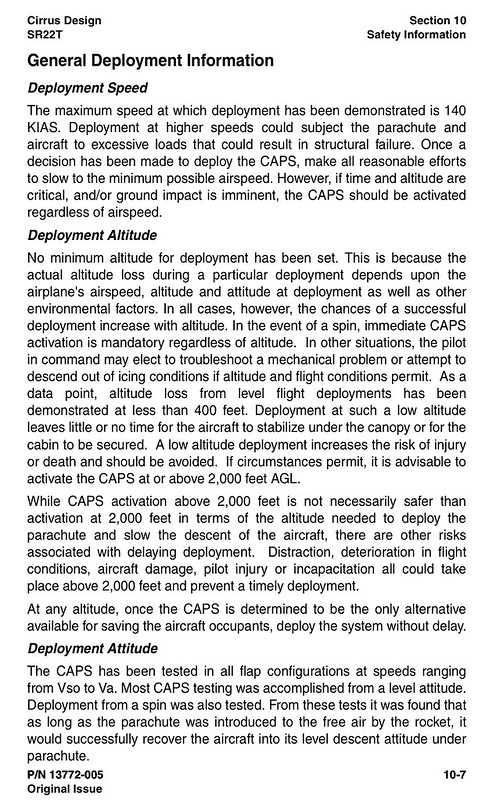SixPapaCharlie
May the force be with you
- Joined
- Aug 8, 2013
- Messages
- 16,016
- Display Name
Display name:
Sixer
Usually people complain about shooting..."One of the nice features of this aircraft is it has a shoot," said Brian O'Keefe, of the Des Moines Fire Department.
Good thing it had that "shoot".
Good thing. I'm surprised more planes don't have "shoots" since they've been around since 192 (CXCII), when I think the Emperor Commodus made them mandatory before he was assassinated."One of the nice features of this aircraft is it has a shoot," said Brian O'Keefe, of the Des Moines Fire Department.
This is why I hate journalists.KCCI 'News' said:Plane parachutes have been around since 192, but according to the Smithsonian Air and Space Museum, the FAA didn't approve them for use until 1993
Pretty good to see it do is job at 800-900 feet.That is on the very low end of the envelope
8 seconds in the older models. I believe 10 or 12 in the newer ones. My min pull altitude is 500 agl. I think the newer ones it is 1000.That does seem low, but if the aircraft is under control I would imagine you can be lower than if you are descending rapidly, etc. How long does the rocket take to deploy?
So what caused the engine failure? Sure seems to happen a lot in the Cirrus models . . .
So what caused the engine failure? Sure seems to happen a lot in the Cirrus models . . .
I ran a quickie analysis (just searched for "Engine" in the Probable Cause) of Cirrus engine failures. I omitted those that were pure pilot error (fuel exhaustion/starvation), and trimmed a PC or two to eliminate information not strictly related to the engine.These Cirrus engine failures are certainly odd. What's the oldest Cirrus in the world? 17 years old?
There can be a pretty limited number of explanations for this...
A good number of these is failure to properly torque through bolts on the engine. Pretty scary when we are now faced with FAA ADs that require arguably unnecessary engine disassembly. It will be interesting to see how many of these engines result in more failures than the AD was supposed to be addressing. It goes from a single cylinder failure to a catastrophic complete engine loss.I ran a quickie analysis (just searched for "Engine" in the Probable Cause) of Cirrus engine failures.
8 seconds in the older models. I believe 10 or 12 in the newer ones. My min pull altitude is 500 agl. I think the newer ones it is 1000.

i am wondering does Cirrus have higher % "engine out" per planes built than other single engine plane manufacturer.
A good number of these is failure to properly torque through bolts on the engine. Pretty scary when we are now faced with FAA ADs that require arguably unnecessary engine disassembly. It will be interesting to see how many of these engines result in more failures than the AD was supposed to be addressing. It goes from a single cylinder failure to a catastrophic complete engine loss.
What would it take to make the Cirrus shoot a zero-zero capable one? Bigger rocket?
What would it take to make the Cirrus shoot a zero-zero capable one? Bigger rocket?
In the past, I've run analyses of Cirrus accidents against Cessna 210s, Cessna 172s, and a combined set of Glasair and Lancairs. I haven't run comparisons against fleet size (yet), since the Cirrus is so much newer. When you have a plane that's in production for less 20 years, it's a lot more likely that the great majority of the planes are still actively flying. The FAA re-registration process affects this, but I'm still anticipating that more of the older designs are licensed but inactive. This, of course, would skew the results.i am wondering does Cirrus have higher % "engine out" per planes built than other single engine plane manufacturer.
Interesting.A buddy of mine had an engine failure in a Cirrus a few years ago. The engine-driven fuel pump failed. Cirrus said it was the first such failure in their records (or at least that's what I seem to recall). When it happened, my buddy turned on the electric fuel pump, but no restart. IIRC, he found out later that the electric fuel pump will not supply enough fuel for the engine to run without the engine-driven pump. This was news to my friend. So much for redundancy. Oh well, it's got a chute.
By the way, he DID NOT deploy the parachute. He landed safely in a field with only minor damage to one of the wheelpants. The first question Cirrus asked him was, "why didn't you pull the handle?" In his situation, he had a very good field available, and there were power lines downwind of his position, so he chose to do what we all train to do, fly the airplane.
I appreciate the comparisons you document. Is there any way to document the number of accidents (total or by cause) per hours flown of various aircraft?In the past, I've run analyses of Cirrus accidents against Cessna 210s, Cessna 172s, and a combined set of Glasair and Lancairs. I haven't run comparisons against fleet size (yet), since the Cirrus is so much newer.
